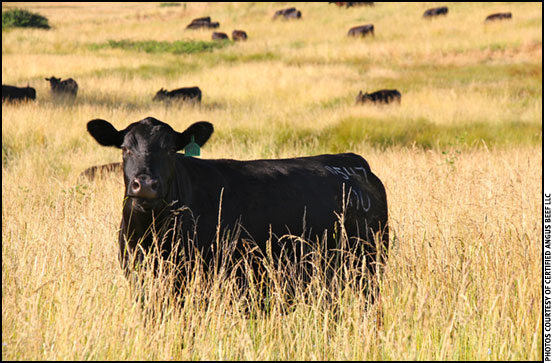MARKETING...

Billion, with a ‘B’
Certified Angus Beef® brand sales surpass 1 billion pounds.
Angus producers knew they could create a brand of beef that would sell millions of pounds in a year, but more than a billion? Let’s not get carried away, the organizers would have said. Yet upon reflection, some might have wondered.
That year has come and gone now.
The Certified Angus Beef® (CAB®) brand’s 38th fiscal year (FY), ending Sept. 30, carved a spot in history as the first time global sales surpassed 1 billion pounds (lb.).
For the 18,000 partners joined by a common mission, CAB President John Stika said the milestone brings a reason to celebrate. More than that, it brings appreciation for thousands of individual successes that led to that historic mark. Read more.
Ag Outlook: Not so good, not all bad
Basse predicts price plateaus for most commodities.
“Who is going to flinch first?”
Dan Basse, president of AgResource Co., said that’s the main question he and his team ponder when looking at this “plateau” phase in the ag markets.
“Is it your neighbor that’s going to cut back? Is it you?” the analyst asked, as he addressed cattle feeders and allied industry representatives at the Feeding Quality Forum last month.
The world has added 179 million crop acres during the last decade, and livestock production is currently in a “dynamic expansionary phase,” Basse said. Ethanol demand has matured and a strong U.S. dollar hurts global competition. Read more.
Different Risk Management
Improved breeding for quality beef can gain top prices for herd owners.
Cow herd owners leery of the futures market or insurance for risk management can look to quality beef for protection.
Scott Brown, University of Missouri (MU) livestock economist, discussed that option at the MU Thompson Farm field day Tuesday, Sept. 20. He asked the farmers present if any were using risk management. No hands went up.
“You could have made lots of money with risk management,” he added. Read more.
Beef Segmentation
How the beef value chain works.
When cattle prices erratically head lower, it’s easy to take issue with reports of higher packer margins or retail beef prices that still seem relatively high. In a volatile market, the segments along beef’s supply chain often see much above- or below-average returns.
“A lot of our beef producers eat their own product,” notes Brent Eichar, senior vice president for the Certified Angus Beef® (CAB®) brand. “So at times there is a bit of a disconnect over how we got from $1.60 [per hundredweight] cattle last year to $14.99 [per pound] ribeye steak.” Read more.

Ginette Gottswiller
The Source:
Putting Customers First
Making sure your calves’ performance guarantees profits and happy customers.
Customer satisfaction is something you can focus on to gain more information on your calves. How many times have you called the feedlot to find out if your calves were sick, or weren’t performing well?
Unfortunately, most ranchers sell their calves, load them on the truck, get the check and that is the end of the transaction. Be the exception: Pick up the phone and ask the feedlot manager the important questions. Build a relationship with him — after all, he is the next step in the chain. If you have done a good job managing your calves, chances are that feedlot knows how much effort you put forth. Read more.
Field Metrics for Packing Plants and Feedlots
Feet and leg issues should be prevented before they become an industry issue.
“There have been light-years of improvement in packing plants,” said Temple Grandin, professor of livestock behavior and welfare at Colorado State University. “The 1980s and 1990s were truly horrible.”
She said a USDA baseline study looking at the percentage of beef plants that stunned 95% or greater with the first shot in 1996 showed only 30%, but it improved drastically and by 1999 reached 90%. In 2009, it was 100%. The USDA survey in 1996 was prior to industry-wide auditing, but then individual restaurants like McDonald’s started auditing, and now major customers continue audits. Continuous auditing for measurable traits maintains good performance. Read more.
USDA Moves Forward with Flawed GIPSA Rules
NCBA says the rule will do more harm than good.
In a letter to the National Cattlemen’s Beef Association (NCBA), USDA acknowledged that the agency would continue the rulemaking process on the 2010 Grain Inspection, Packers and Stockyards Act (GIPSA) proposed rules. The proposed rulemaking was initially undertaken in 2010 and quickly defunded by Congress, which recognized them as a flawed concept that limits producers’ marketing options while adding layers of bureaucracy and opening the door to litigation. NCBA President Tracy Brunner said these provisions were troubling in 2010 and remain a major concern six years later. Read more.
In the Cattle Markets
Next options for the fall calf crop.
In the midst of marketing this year’s fall calf crop, it is useful to step back and note marketing prospects and options available to buyers and sellers of calves. For context, note the current projected price of selling a 550-pound (lb.) calf in Salina, Kan., on Oct. 19, 2016, is $137.28 per hundredweight (cwt.). The main marketing alternatives available include selling at weaning, preconditioning, backgrounding, drylot wintering and winter grazing. Read more.
Angus Calendar
To view the Angus Calendar, a complete list of Angus sales, click here.






